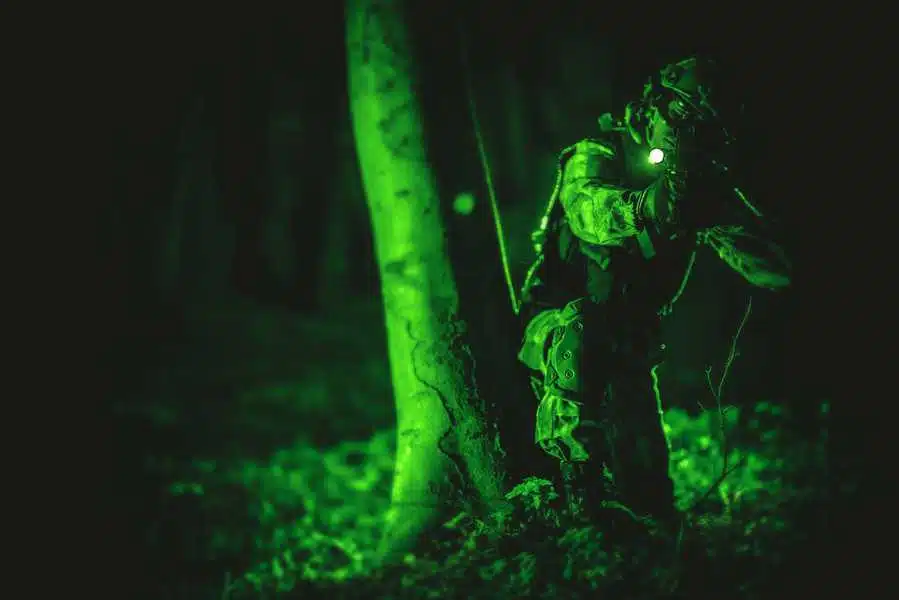Every person who has ever looked to buy a night vision scope has been faced with one major issue – night vision generations. What are they? What are the differences between them? Why are gen-3 scopes so expensive? In this article, I will try to go through all of these topics, answer all of your questions, and walk you through the main features, advantages, and disadvantages of every generation.
The first thing we need to discuss is how many generations are there. Currently, we have:
- Generation 1
- Generation 2
- Generation 3
- Generation 4 (unofficial)
- White Phosphor Technology (WPT)
These generations aren’t referring to the device itself but are rather descriptive of the IIT (image intensifier tube). That tube is responsible for creating the image and amplifies what you see in the dark by accelerating the electrons received by your NVD (night vision device). I’ve talked about how these devices work and the different types of components they have in my night vision scopes buyer’s guide. There, on top of that information, you will also find some of the best models for this year and a few extra tips on how to choose the right model for your needs.
Now, let’s dive into each one of those now and learn more about them and how they compare against the rest…
Gen-1 Night Vision
The main theme of gen-1 NVDs is that they are affordable and better than having no night vision at all. This technology is quite old and modern gen-1 devices are direct successors to the very first night vision devices used in the Vietnam war.
Modern gen-1 scopes aren’t as bulky as the old ones and are far more advanced in their tech but deep down they still use the same light amplification technique that was used a few decades ago. They will amplify the light thousands of times allowing you to see in the dark at short ranges. Their effective range is increased by built-in IR illuminators that shine infrared light in the 800-950nm spectrum.
Pros
- Abundance of models on the market
- Most Gen-1 NVDs are very affordable
- Good for short to medium-range shooting and hunting
- Great for home security cameras
- Easy to use
- Can be improved with a stronger IR illuminator
- Battery life is decent
Cons
- Very low effective range compared to other generations
- Images have lower resolution and static noise
- The outer edges are blurry due to Geometric Distortion
- In the case of excessive light, there is “blooming”
- Shorter life expectancy compared to other generations
One major disadvantage of gen-1 night vision devices is that due to their reliance on illuminators they become easily visible for other NVDs. A great example of a gen-1 rifle scope is the Sightmark 4.5x42S Photon RT which uses an 850nm illuminator and an internal digital display for its imaging.
Gen-2 Night Vision
The second-generation night vision devices is a huge improvement from the first one. So huge that it is actually closer to Gen-3 than to Gen-1. The main difference is that Gen-2 NVDs use a micro-channel plate. That is a plate placed directly behind the photocathode which is made of a lot of parallel glass tubes. These tubes further amplify the electrons passing through the device by adding thousands of electrons to the final image. All this results in a much brighter and clearer image than Gen-1 night vision devices. Gen-2 scopes and monoculars are used by professionals or law enforcement and are twice or triple the price of normal Gen-1 models.
Pros
- Much brighter images in pitch black conditions
- Better resolution and image clarity
- Don’t rely solely on an illuminator
- Their range goes up to 200-300 yards
- Longer life expectancy
- Less blooming than Gen-1
Cons
- Much more expensive than Gen-1
- Battery life isn’t improved a lot (can be worse in some cases)
- Some Gen 2HPT can cost as much as a Gen-3 NVD
There are a few sub-divisions when it comes to the second and third generations. For instance, there are Gen-2ST (standard tube) which are the base models. Above those, there are Gen-2CGT/MS (Custom Grade Tubes/Mil-Spec Grade) and Gen-2HPT (high-performance tubes). The high-performance tube models are very expensive and usually reach the realm of Gen-3 models which stops making sense since Gen-3 has all the advantages plus much-improved battery life.
Gen-3 Night Vision
Gen-3 is one of the best night vision technologies today and is also one of the most expensive ones. What this generation improves over the previous one is that it adds gallium arsenide to the tube’s photocathode which results in a brighter and crisper image. There are also ion barrier films in place here which bulk up the price even further but also increase the life expectancy of gen-3 NVDs. For our military, gen-3 is the current standard, although there are new technologies being implemented already but more on that later. In pitch-black conditions, these devices blow gen-1 and 2 completely out of the water.
Gen-3 devices have four variations:
- Gen-3ST (standard tubes) – slightly improved image quality over the standard ones
- Gen-3A – further improves image clarity and overall performance
- Gen-3AG (auto-gated) or Gen-3P (pinnacle) – 3AG and 3P are the current best Gen-3 devices can offer and are almost identical and used interchangeably
Pros
- The best pitch-black performance money can buy
- Super long ranges (300+ yards) in pitch-black conditions
- Great resolution
- Crisp and bright images
- No blooming
- Can operate under any type of light conditions
- Market-leading passive operation
- 10,000+ hours of life expectancy
Cons
- Extremely expensive
- Can be too complicated for new users
- Some models have a ton of options which sometimes malfunction
- The built-in rangefinders, wind direction, elevation, and trajectory functions aren’t always perfect
Gen-4 Night Vision
Officially, there is no fourth generation of night vision devices (yet). Some companies took their gen-3 devices and removed their ion barrier film and used that to market them as gen-4. Even if that increased image brightness in pitch-black conditions, it significantly reduced the life expectancy of the device, which quickly made the US army remove gen-4 from the official classification. Still, by further improving this idea and “gating” the whole light-transmitting system, gen-4 offers a substantial increase in the target identification ranges of gen-3 scopes. This technology is called “filmless” for now instead of the easily marketable term “gen-4”.
Other NV Technologies
There are a few other night vision technologies that are currently breaking into this realm and are further improving all the generations.
White Phosphor Technology
This technology is currently available across all the generations and instead of the traditional green and black image, it gives a black and white picture to its user. These types of images are more natural and in certain conditions have more contrast. It is being developed further each year and it seems like WPT is the future of all the current generations.
Filmless (Unfilmed) Technology
Filmless tech is at the forefront of night vision research at the moment. As I mentioned, these devices remove the ion barrier film and add an auto-gating tech inside. This increases their range and doubles their light sensitivity in pitch-black conditions compared to Gen-3ST models. Filmless devices are also advertised as Gen-3AG or Gen-3P.
Digital NVDs
Digital night vision devices are a little more budget-friendly and are slightly different in their architecture than normal night vision devices. They have a chip/processor inside that amplifies the detected light from their illuminator. The benefit of having an internal computer do all the work is that you can have really cheap models as well as really expensive ones that give gen-2 devices a run for their money.
Price-wise, digital NVDs get really close to Gen-1 models. They also allow the user to record what he’s seeing through the scope and have a bunch of other digital functions such as rangefinders and ballistic data.
CORE (Ceramic Optical Ruggedized Engine)
These devices use an internal ceramic plate instead of a glass one and the tech is mostly targetted towards Gen-1 scopes. That leads to improved image quality and longer life expectancy. The good part is that it doesn’t affect the price too much, if at all.
One prime example of this technology is the ATN X-Sight II HD Night Vision Scope.
Side-By-Side Comparison

There are many environments in which you can test the different generations but a moonlit night seems to be the fairest for the first generation since it provides enough lighting to produce a good image. In that case, every next generation just sharpens the image and provides better details at a further distance. In pitch-black conditions, gen-1 would really fall behind the others unless it has a great IR illuminator. In all cases, though, gen-1 and gen-2 models will have some black dots inside the tube, as well as substantially grained image. Also, gen-1 will experience the most blooming when you’re facing a light source, while the rest will be more well-balanced no matter the lighting.
Why Lenses Matter
Night vision scopes, goggles, and monoculars rely heavily on their optics for image quality. The lenses are directly responsible for light transmission and having fully-multi coated lenses will help you a great deal. This is why you need to look for models with good lenses as even the best image-intensifier tube cannot compensate for a lousy objective lens.
Lens diameter is another feature that directly reflects how much light enters the tube and can thus greatly improve (or worsen) your image depending on the objective lens size.
Final Words
Whether you need to get a Gen-1 or Gen-2 device mainly depends on what you are planning to do with it. For short-range hunting, I’d suggest getting a gen-1 or gen-2 scope that will save you a lot of money and will bring decent image quality for the price. Still, knowing the difference between the different night vision generations is an important part of your gear knowledge that will make it easier for you further down the road when you are shopping for a new night-time hunting scope or monocular.



